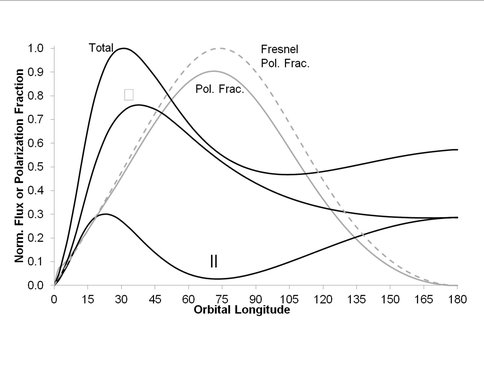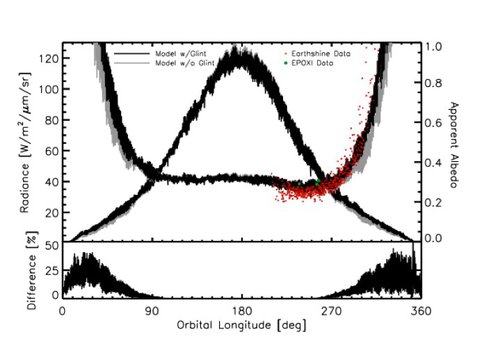2010 Annual Science Report
 VPL at University of Washington
Reporting | SEP 2009 – AUG 2010
VPL at University of Washington
Reporting | SEP 2009 – AUG 2010
Earth as an Extrasolar Planet
Project Summary
Earth is the only known planet that can support life on its surface, and serves as our only example of what a habitable planet looks like. This task uses distant observations of the Earth taken from spacecraft combined with a sophisticated computer model of the Earth to understand the appearance and characteristics of a habitable planet. With our model, we can generate accurate simulations of the Earth’s brightness, color and spectrum, when viewed at different time-intervals, and from different vantage points. We are using these simulations to understand how we might detect signs of an ocean on a distant planet, and to understand the limitations of surface temperature measurements when a planet has significant cloud cover.
Project Progress
During the last year, we submitted for publication our work to extensively validate the Virtual Planetary Laboratory’s 3-D spectral Earth model against a wide range of data (Robinson et al., 2010a).
We have used the validated model to simulate Earth’s visible spectrum through an entire year (completing VPL Task A) and have shown that glint from Earth’s oceans causes the planet to be as much as 100% brighter than a non-glinting, partially-clouded Earth (Robinson et al., 2010b). The effect is most detectable at near-infrared wavelengths, where Rayleigh scattering does not obscure the surface, and at crescent phases, where the glint spot is more reflective and covers a significant fraction of the illuminated disk. The glint component of Earth’s reflectivity may be detectable with a TPF-like telescope, allowing us to obtain direct evidence for oceans on the surface of an extrasolar planet.
We also used models to investigate the feasibility of using polarized and unpolarized lightcurves to detect oceans on planets with different atmospheres, and to investigate the possibility of false positive detections of oceans from atmospheric and surface effects on a dry planet (Zugger et al., 2010). Our calculations suggest that, even without interference from clouds, waves, gaseous absorption, or aerosols, polarization of planet-scattered light by itself may not positively identify the presence of an ocean under an Earth-like atmosphere. However polarization adds another dimension which can be used in combination with unpolarized (radiometric) orbital light curves and contrast ratios, to detect extrasolar oceans, atmospheric water aerosols, and water clouds.
In other work, VPL team members either led or worked with other NASA EPOXI team members to analyze EPOXI observations of the Earth’s poles (Shields et al., 2010), and photometric measurements of planets in our Solar System (Crow et al., 2010). The VPL’s 3-D Earth model comparison with the EPOXI polar data was used to explore detectable differences in light curve ampitude, color, atmospheric effects, surface temperature and compositional differences between the poles and equator, with implications for future observations of exoplanets at different evolutionary phases and viewing geometries. The photometry of Solar System planets work looked at providing optimal filters for discrimination of different planet types from photometry alone.
In retrieval and detectability studies, EPOXI Earth data were analyzed to retrieve spatial information to validate techniques retrieval of spatial information from multi-wavelength, temporally, but not spatially-resolved photometry of extrasolar planets (Cowan et al., 2009). Work is ongoing to improve this original technique. Work was also done to determine signal to noise and exposure time necessary to resolve the spectral features of a selection of Earths (modern realistic, modern cirrus-covered, modern no-cloud, archean) around various stars using a simulator for a proposed TPF-style coronographic mission.
Fig. 2 Total reflected light and parallel () and perpendicularly () polarized reflected light as a function of orbital longitude for a water-covered planet. The polarization fraction, defined as Iperp/(Iperp + Ipar), peaks at 74 degrees, when the glint spot on the planet’s surface is at the Brewster angle (53 degrees). The light from a Lambertian scatterer is unpolarized. [From Zugger et al., Ap. J., in press.]
This plot shows the increase in reflectivity near crescent phases for an Earth-like planet with an ocean as it orbits around a distant star. The bell-shaped curve shows the Earth’s brightness as a function of phase, modeled by the VPL 3-D spectral Earth model over the course of a year. Full phase is at 180 degrees, crescent phases are closer to 0 and 360 degrees phase. The U-shaped curve shows the model predictions for the Earth’s reflectivity, normalized to that expected from a surface that scatters isotropically (a Lambert sphere). If Earth behaved like a Lambert sphere, then the ratio curve would be a straight line at about 0.3 albedo, at all phases. Instead, our model (and the Earthshine and EPOXI data plotted over it) show that the apparent reflectivity of the Earth deviates strongly from a Lambertian sphere at phases shortward of 90 degrees and longward of 270 degrees. This is due to the addition of both forward scattering from clouds, which dominates this behavior, and specular reflectance from the Earth’s ocean. The difference between the black and grey U-curves shows the effect from ocean, as distinct from clouds, and this difference is plotted in the window below the curves. Our modeling suggests that the presence of a reflecting ocean can be disentangled from the forward-scattering effect of clouds, and may produce an enhancement in the Earth’s reflectivity of as much as 50% at some crescent phases (Robinson et al., 2010).
Publications
-
Cowan, N. B., Agol, E., Meadows, V. S., Robinson, T., Livengood, T. A., Deming, D., … Charbonneau, D. (2009). ALIEN MAPS OF AN OCEAN-BEARING WORLD. The Astrophysical Journal, 700(2), 915–923. doi:10.1088/0004-637x/700/2/915
-
Robinson, T. D., Meadows, V. S., & Crisp, D. (2010). DETECTING OCEANS ON EXTRASOLAR PLANETS USING THE GLINT EFFECT. The Astrophysical Journal, 721(1), L67–L71. doi:10.1088/2041-8205/721/1/l67
-
Robinson, T. D., Meadows, V. S., Crisp, D., Deming, D., A’Hearn, M. F., Charbonneau, D., … Wellnitz, D. D. (2011). Earth as an Extrasolar Planet: Earth Model Validation Using EPOXI Earth Observations. Astrobiology, 11(5), 393–408. doi:10.1089/ast.2011.0642
-
Zugger, M. E., Kasting, J. F., Williams, D. M., Kane, T. J., & Philbrick, C. R. (2010). LIGHT SCATTERING FROM EXOPLANET OCEANS AND ATMOSPHERES. The Astrophysical Journal, 723(2), 1168–1179. doi:10.1088/0004-637x/723/2/1168
- Crow, C., McFadden, L.A., Robinson, T., Meadows, V., Livengood, T.A., Hewagama, T., Barry, R.K., Deming, L.D. & Lisse, C.M. (2010). American Astronomical Society, DPS meeting #42.
- Kasting, J.F. (2010). How to find a habitable planet, in Pathways Towards Habitable Planets. ASP Conf. Series. Astron. Soc. Pacific, San Francisco.
- Robinson, T.D., Meadows, V. & Crisp, D. (2010). Earth as an Extrasolar Planet. American Astronomical Society, DPS meeting #42.
- Robinson, T.D., Meadows, V.S. & Crisp, D. (2010). Detecting Oceans on Extrasolar Planets. Astrobiology Science Conference 2010: Evolution and Life: Surviving Catastrophes and Extremes on Earth and Beyond. League City, Texas.
- Robinson, T.D., Meadows, V.S., Deming, D., A’Hearn, M.F., Charbonneau, D., Hewagama, T., Lisse, C., Livengood, T., McFadden, L., Seager, S., Wellnitz, D.D. & Team, E.E. (2010). Earth as an Extrasolar Planet: The VPL Earth Model Validated Against EPOXI Observations. American Astronomical Society, DPS meeting #41.
- Shields, A.L., Meadows, V.S., Robinson, T.D., Deming, L.D., A’Hearn, M.F., Charbonneau, D., Hewagama, T., Lisse, C., Livengood, T., McFadden, L., Seager, S., Welnitz, D.D. & Team, E.E. (2010). Earth as an Extrasolar Planet: Comparing Polar and Equatorial Views. Astrobiology Science Conference 2010. League City, TX.
- Williams, D.M. & Zugger, M. (2010). Polarization Of Starlight By Exoplanets With Watery Surfaces. American Astronomical Society, AAS Meeting #215.
- Zugger, M., Williams, D.M. & Kasting, J.F. (2010). Polarization of Starlight by Exoplanet Oceans. Astrobiology Science Conference 2010. League City, Texas.
- Zugger, M.E., Kasting, J.F., Williams, D.M., Kane, T.J. & Philbrick, C.R. (In Press). Simulated light curves from ocean and Lambertian exoplanets with Rayleigh-scattering atmospheres. Ap Journal.
-
PROJECT INVESTIGATORS:
-
PROJECT MEMBERS:
David Crisp
Co-Investigator
James Kasting
Co-Investigator
Nicole Evans
Undergraduate Student
-
RELATED OBJECTIVES:
Objective 1.2
Indirect and direct astronomical observations of extrasolar habitable planets.
Objective 7.2
Biosignatures to be sought in nearby planetary systems



